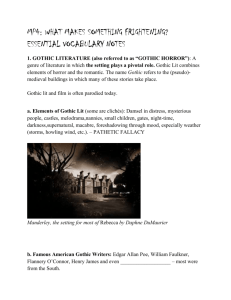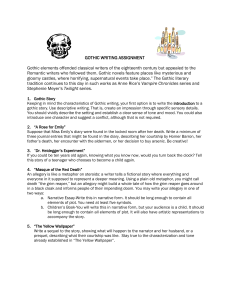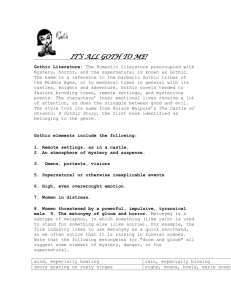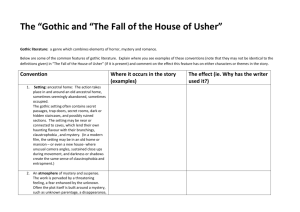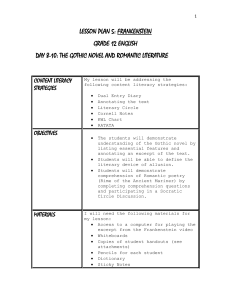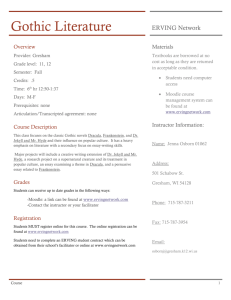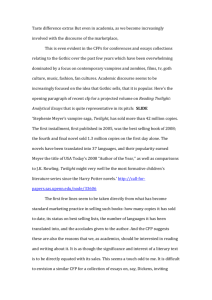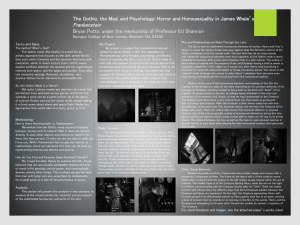The Other is a key concept in continental philosophy, opposed to the
advertisement
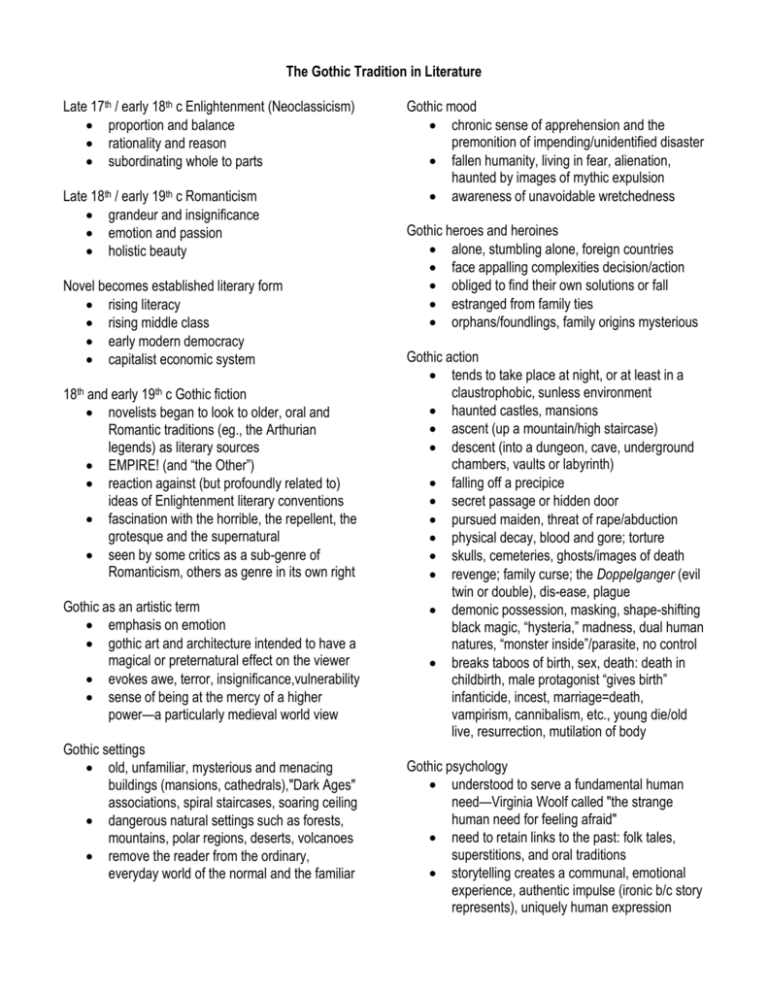
The Gothic Tradition in Literature Late 17th / early 18th c Enlightenment (Neoclassicism) proportion and balance rationality and reason subordinating whole to parts Late 18th / early 19th c Romanticism grandeur and insignificance emotion and passion holistic beauty Novel becomes established literary form rising literacy rising middle class early modern democracy capitalist economic system 18th and early 19th c Gothic fiction novelists began to look to older, oral and Romantic traditions (eg., the Arthurian legends) as literary sources EMPIRE! (and “the Other”) reaction against (but profoundly related to) ideas of Enlightenment literary conventions fascination with the horrible, the repellent, the grotesque and the supernatural seen by some critics as a sub-genre of Romanticism, others as genre in its own right Gothic as an artistic term emphasis on emotion gothic art and architecture intended to have a magical or preternatural effect on the viewer evokes awe, terror, insignificance,vulnerability sense of being at the mercy of a higher power—a particularly medieval world view Gothic settings old, unfamiliar, mysterious and menacing buildings (mansions, cathedrals),"Dark Ages" associations, spiral staircases, soaring ceiling dangerous natural settings such as forests, mountains, polar regions, deserts, volcanoes remove the reader from the ordinary, everyday world of the normal and the familiar Gothic mood chronic sense of apprehension and the premonition of impending/unidentified disaster fallen humanity, living in fear, alienation, haunted by images of mythic expulsion awareness of unavoidable wretchedness Gothic heroes and heroines alone, stumbling alone, foreign countries face appalling complexities decision/action obliged to find their own solutions or fall estranged from family ties orphans/foundlings, family origins mysterious Gothic action tends to take place at night, or at least in a claustrophobic, sunless environment haunted castles, mansions ascent (up a mountain/high staircase) descent (into a dungeon, cave, underground chambers, vaults or labyrinth) falling off a precipice secret passage or hidden door pursued maiden, threat of rape/abduction physical decay, blood and gore; torture skulls, cemeteries, ghosts/images of death revenge; family curse; the Doppelganger (evil twin or double), dis-ease, plague demonic possession, masking, shape-shifting black magic, “hysteria,” madness, dual human natures, “monster inside”/parasite, no control breaks taboos of birth, sex, death: death in childbirth, male protagonist “gives birth” infanticide, incest, marriage=death, vampirism, cannibalism, etc., young die/old live, resurrection, mutilation of body Gothic psychology understood to serve a fundamental human need—Virginia Woolf called "the strange human need for feeling afraid" need to retain links to the past: folk tales, superstitions, and oral traditions storytelling creates a communal, emotional experience, authentic impulse (ironic b/c story represents), uniquely human expression Frankenstein as gothic novel Allusions to John Milton’s Paradise Lost (1667), epic rendition of “Genesis” – creature will read Milton "Did I request thee, Maker, from my clay / To mould me man? Did I solicit thee / From darkness to promote me?--," Paradise Lost book 10, epigraph of Frankenstein Creature + Adam, "united by no link to any other being in existence", Satan, outcast & wretched Victor, god/creator, Adam, once innocent child, Satan, rebellious over-reacher & vengeful fiend Edenic world lost through Frankenstein's single-minded thirst for knowledge Victor, Promethean figure, striving against human limitations to bring light & benefit to humankind Glories in ability to create a facsimile of the human self. fall results not from creative enterprise, from failure & inability to love creation Individual desire v familial & social responsibility, Romantics: individualistic/self obsessed creativity v self denial, social harmony Nightmarish murders, demon-like creature, terror of unknown, destruction of idyllic life in nature by dark, ambiguous force Frankenstein = novel in the gothic tradition, situates good & evil as psychological battle w/in human nature Creator & creature initially "benevolent" feelings & intentions, become obsessed w/ destruction & revenge Manipulates conventions, stock gothic villains replace w/ morally ambiguous characters reflect depth & complexity of human psyche Weird stuff nerds notice: Frankenstein associated w/ creature rather than creator, doppelgangers? Identities confused deliberately? Divided self, monstrous, destructive force w/in “civilized” humans, opposites not reconciled, destroy each other Link events, dates, & names novel & those in Mary's life; begins 11 December 17--, ends 12 September 17—? Walton’s to sister Margaret Walton Saville (initials are those of Mary Wollstonecraft Shelley) Time period similar in duration to Mary Shelley's third pregnancy, during which she wrote Frankenstein Day & date Walton first sees creature, Monday, 31 July, coincides in 1797, year Mary was born Novel ends 12 September 1797, two days > Wollstonecraft's death – consequence of Mary’s birth? The Concept of the Other The Other singled out as different the unconscious, silence, madness, the impossibly good or incomprehensibly evil other of language (references and “the unsaid”) a person's definition of the Other part of Problems what defines the self relative to other people, ideas, and cultures tendency towards relativism if the Other Implications of the Other for the colonial mindset leads to a notion that ignores any commonality of truth (normative) can help us understand the processes by which societies and groups exclude unethical uses to reinforce social, Others in order to subordinate them cultural, economic, political divisions Hegel demonstrates western societies’ practice and POV to gain and maintain power “Master-Slave Dialectic” over occupied people and lands Sartre Otherness and personal and cultural identity “Being for Other” people construct roles for themselves in Lacan relation to an Other as part of a fluid “The Mirror” process of action-reaction Lévinas both Othering and being Othered! “The Infinite Other”

